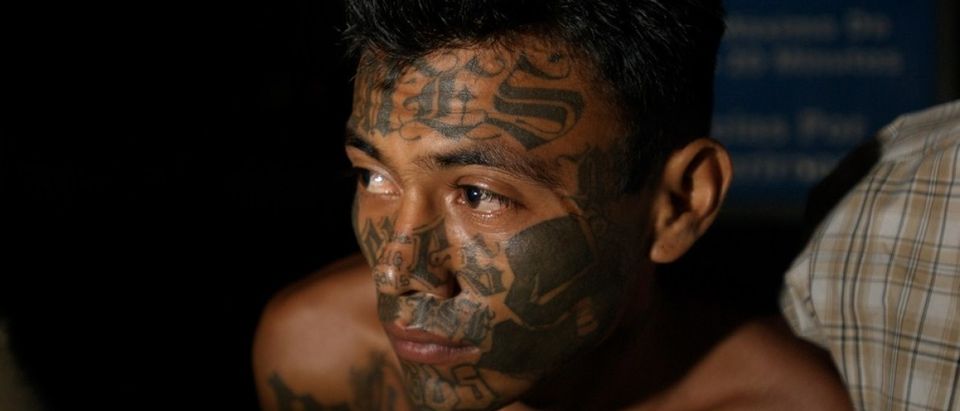Mara Salvatrucha, known widely as MS-13, is one of the deadliest and most feared street gangs in the world. Signature among its most ruthless troops is a particularly disturbing look of extensively tattooed members, known as Maras.
The culture and history surrounding the tattooing practices of MS-13 is long and of great importance to properly understanding the organization. MS-13 was declared a transnational criminal organization (TCO) by the U.S. Treasury Department in October 2012.

REUTERS/Ulises Rodriguez
It is the only Latin American street gang to have achieved the TCO designation by the Treasury Department. Los Zetas is also a TCO, however, they are a paramilitary cartel rather than a street gang.
To better comprehend the importance of tattoos to MS-13, The Daily Caller News Foundation reached out to Latin American transnational criminal activity expert Douglas Farah and to a team of analysts at the firm Southern Pulse, which studies Latin American issues.
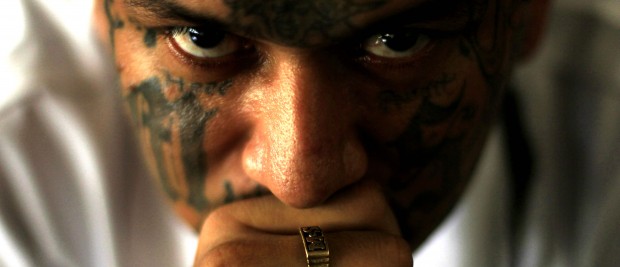
REUTERS/Ulises Rodriguez
Tattooing is a MS-13 tradition of a bygone era, according to Farah, “The gangs stopped tattooing now pretty much. They initially stopped because they didn’t want to be identified but now it’s become a sort of cultural landmark because they view themselves as being past that stage.”
Maras, “went from the stage where they were starting to tattoo and telling life stories through their tattoos on their bodies, including the famous ones on their backs,” Farah told TheDCNF. “There’s a lot of symbology mixed in, an entire sort of language.”
It is essential to Maras that, “everything has to add up to 13. If you ask them about their tattoos, they’ll show you how 13 matches up on everything which is really the magic number for them. For 18th Street Gang, it’s 18” Farah, the president of national security consulting company IBI Consultants, LLC, said.
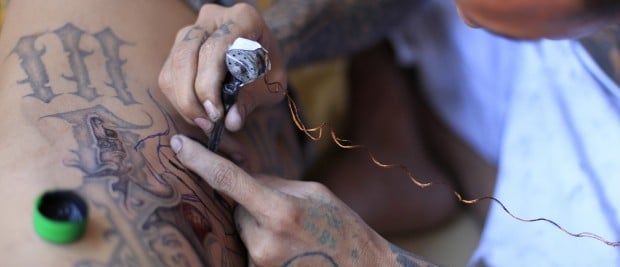
REUTERS/Ulises Rodriguez
“The tattoo culture was already common among the main Mexican gangs controlling Los Angeles suburbs, especially ‘La Meravilla’ or ‘M’ ( ‘La Eme’ – m in Spanish) one of the oldest Mexican mafia gangs that started their activity in the ’50s becoming ‘the mentor’ of California street gang culture and inspiring new generations of gangs,” Southern Pulse analysts told TheDCNF via email.
Farah, who worked as an investigate and foreign affairs journalist for 20 years, explained that tattoos were a way of building a community. MS-13 began as a street gang in 1980s Los Angeles with its membership consisting of Central American refugees fleeing civil war and other strife in their home countries. Many MS-13 members are Americans or dual-citizens, predominantly of El Salvador or Honduras.
Due to their American background, several MS-13 members who were deported from the U.S. did not speak Spanish. Getting inked was “a survival mechanism of self-identification and wanting to create this sort of family, this group, other from society,” according to Farah, who has spoken with many MS-13 gang members over the years.
“MS-13 tattoos partially mean loyalty to the group or ‘family,’ but they mainly demonstrate the identification to a specific lifestyle, representing the culture of the street. Also in this scenario, tattoos were like like a ‘baptism’ of the member into a group, representing the turning point of the appartenance. Though it has changed in the past five years or so, the tattoos used to be a way of demonstrating lifelong commitment to the gang. The more prominent the tattoos, the less likely the person could leave the gang lifestyle, with facial tattoos being the ultimate representation of commitment,” Southern Pulse analysts told TheDCNF.
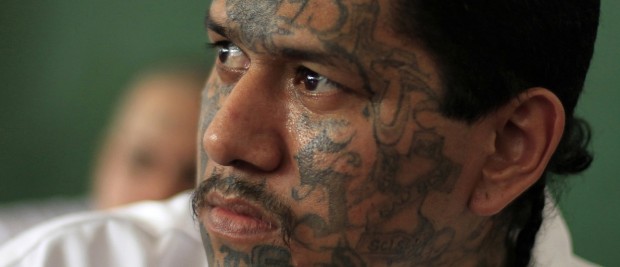
REUTERS/Ulises Rodriguez
Since the implementation of tougher policing tactics in El Salvador, known as Mano Dura, or Hard Fist, Maras have toned down their public displays of loyalty and thereby not been as fond of tattoos lately.
According to the team of Southern Pulse analysts via email:
The implementation of effective policies against gangs, such as the so-called ‘Mano Dura,’ definitely changed the tattoo culture among maras members. The identification with a specific group, visually represented by tattoos, is important, but even more important is to preserve that group, and make it more powerful against the enemy. In El Salvador and Honduras, tattoos are usually linked to a street gang membership and in several occasions, governments and law enforcement agencies have persecuted individuals and perpetrated massive arrests just relying on tattoos. Being “invisible” has become an important asset for all the MS-13 members and giving up tattoos is part of keeping their control and escaping from state’s persecutions.
“For that reason, numerous interviews on the ground in Central America suggest that MS-13 and other groups are limiting their tattoos and even encouraging some members to avoid them now. As the groups have ‘professionalized’ and are less focused on the community element of local gang membership, this pragmatic step of avoiding tattoos has made the gangs more difficult to detect,” the analysts continued.
Once Mano Dura was implemented, “not only could they [the authorities] tell how many people you’ve killed and what your rank was but that you were clearly a gang member, there’s no way around that.”
In a post-Mano Dura El Salvador, Farah stated the gangs proceeded to “do a lot smaller things, they went through a phase where a lot of them removed their tattoos, tried to have their tattoos removed.”
Southern Pulse analysts believe tattoos, “will become a vintage representation of membership to the group, more than a requirement. Several aspects of MS-13 are changing and this group is evolving into a more sophisticated criminal organization and the disappearing of the tattoo culture is part of this evolution.”
“For newly minted MS-13 members, there was a huge point of pride in being tattooed, because it’s an identifier,” Farah stated. Part of the purpose of extensive tattooing “was to instill fear, partly to terrify you – which is quite effective. A lot of the old guys still have their tats but they’re pretty much retired now.”
As MS-13 tries to increasingly engage in white collar crime, as to achieve new found veneer of legitimacy, the gang will attempt to attract professionals such as lawyers and accountants, allowing them to expand operations, the Southern Pulse analysts told TheDCNF.
Farah said those who still get tatted have a mentality of, “‘this is who I am, I’m not ashamed of the gang, the gang is my family.’ You know, it’s also kind of like a ‘screw you’ [to the authorities].”
“Although many tattoos represent religious icons, like the Virgin Mary or Jesus Christ, they don’t necessarily demonstrate religious faith. Gang members use those images as part to their attachment to cultural symbolism, aiming to attract the attention of common people,” Southern Pulse continued. “Their main purpose is to make people believe they are attached to religion and faith, but usually the tattoos hide profane meanings. For example in the tattoo representing Jesus Christ, many MS-13 members place an ‘M’ in his crown and and ‘S’ in his long beard, standing for ‘MS.'”
Farah told TheDCNF, “They had a lot of Christian symbology and a lot of satanist symbology. They also have horns, devils, hooves, often juxtaposed with The Virgin [Mary].” Ultimately for Maras, “There’s a constant struggle in that for them, good and evil was: good being the gang, evil being the not gang. Not the moral sense that a lot of us would think.”
The veteran reporter detailed how many people familiar with gang culture believe “that there’s a lot more, let’s say Satanic rituals, but things like Satanic rituals but I don’t think they’re actually, I don’t think they’re actually viewing themselves as worshiping Satan. They have a lot of rituals now around how they kill people; they’re really gory and bloody. The types of methodology of execution have become much more ritualistic.”
“There’s a real mix” of symbology involved, Farah said. Something that is often emphasized in gang tattoos is a Mara’s mother or sister. Mothers are particularly revered, while “girlfriends and lovers” are also depicted.
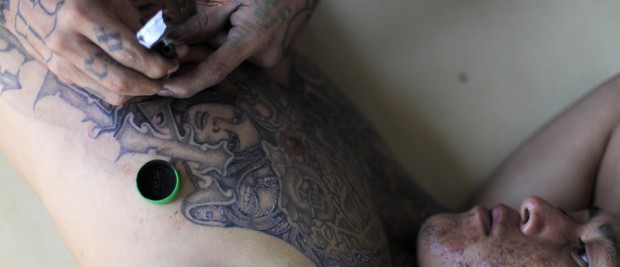
REUTERS/Ulises Rodriguez
“MS-13 tattoos can own specific meanings and they can either represent power and expansion or simply show the choice of sympathizing or belonging to the group. In some cases, tattoos become the expression of a choice, it is the re[con]figuration of a path that was embraced to overcome a hard life and survive. Through religious tattoos, some gang members also look for mercy, trying to justify their cruel and violent acts,” Southern Pulse said.
“Two common specific tattoos are the teardrop, a facial tattoo that often represents someone having been involved in a murder, and the three dot tattoo on the hand or face, signifying there are only three ways gang life ends: Jail, Hospital or Grave.”
Teardrop tattoos are often perceived as indicating a gang member has murdered someone — but that’s not always true, according to Farah. While “it’s not something they like to talk about,” Farah said he knows Maras get inked with “lots of different things — dots between the knuckles, skulls sometimes, teardrops too,” to show their murder rank. Farah stated that he “was never really sure if it was codified or everyone chose their own sort of methodology but I think there are certain things you could tell like maybe some skulls meant that but not all of them, or teardrops.”
To gain more power within El Salvador, Honduras and in the United States, Maras may need to shed these past traditions. “As the structure of MS-13 and other maras in Central America becomes more organized, so their members will try to adapt to the change. MS-13 has become became a new unconventional actor in El Salvador panorama, with control over the territory, financial, political and negotiating power,” according to Southern Pulse.
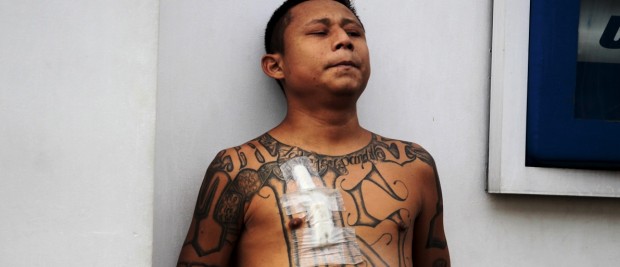
REUTERS/Jose Cabezas
Farah said the shift away from tattoos is “really interesting” because gang members “view that [tattoos] as what they did when they were kids. Now they don’t want to be called Maras, they want to be called La ‘Familia.'”
“They view themselves sort of as a political-military structure instead of a gang and as that, they don’t tattoo because they view that as kind of juvenile now – which is a really interesting change.”
“But now they have in-between their fingers or, I don’t know how people can tell, inside their lips. They’ll always have one small tattoo to identify themselves, probably to prove who they really are if push comes to shove,” Farah continued.
Farah explained to TheDCNF that, “Haircuts are apparently a new way of distinguishing if someone is a gang member or not. They cut a line in a certain way in their hair, they’re doing haircuts now. Not scars, it’s just how they cut their hair, little parts that they cut in.”
Maras’ style of cutting hair is unique to MS-13, and different from the way 18th Street Gang members, for example, cut their hair, according to Farah. They even “wear different kinds of shoes.”
Ultimately, gangsters are ruthless but practical businessmen: Innovation and larger profit margins are worth pursuing at the loss of tradition. MS-13 is entering a new post-tattoo world to keep up in the gang business.
Los Angeles, Washington, D.C., Maryland, and Virginia areas are MS-13 hubs, and it is also growing traction in Boston.
All content created by the Daily Caller News Foundation, an independent and nonpartisan newswire service, is available without charge to any legitimate news publisher that can provide a large audience. All republished articles must include our logo, our reporter’s byline and their DCNF affiliation. For any questions about our guidelines or partnering with us, please contact licensing@dailycallernewsfoundation.org.


